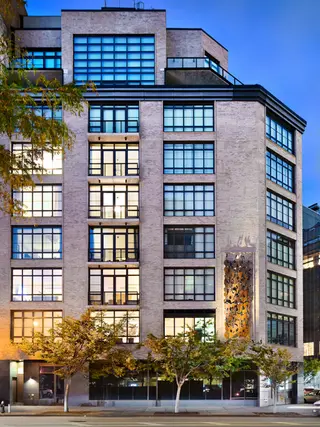 Carter Horsley
Carter HorsleyDec 23, 2011
Carter's Review
Thomas McKay and Garrett Gourlay are the architects of the eleven-story Arman. The building employs a synthetic light-colored and highly textured material for three piers, only one of which extends to the ground floor, on Canal Street, where its height matches that of an adjoining red-brick building to the west, and a glass façade with inset balconies on the east façade on Greenwich Street where the building only rises 7 stories.
History
For many years, Arman, the artist, maintained an outdoor studio on this irregular, triangular-shaped lot on the northwest corner at Canal Street.
Before he died, he sold the site to Red Brick Canal LLC., of which David Slaven is the president, and it sought to incorporate a large sculpture by Arman into a new 11-story residential condominium building on the site at 482 Greenwich Street.
The developer originally sought a floor-to-area-ratio (F.A.R.) of about 7.98 for the site, which was subsequently lowered to about 7.6., but numerous community and civic groups protested claiming that that would be substantially higher than the site's zoning.
In September, 2006, the Board of Standards & Appeals finally approved the granting of a zoning variance to permit the construction of the project but only to a F.A.R. of 6.5.
The site is at the edge of the historic shoreline within a high hazard flood plane and on the former site of a gas station.
According to Deirdre Carson of Greenberg Traurig, who represented the developer, the variance approved required a reduction in the height of the building and in the number of units. Ms. Carson said that the building would still be 11-stories tall, but will contain only 8 condominium apartments.
At a recent hearing before the board, the discussion centered mostly on "hardship" issues and Bill McCorkin, a cost consultant, told the board that mandated acoustic insulation requires that the project s triple-glazed windows have more space between the glass. Mr. Gourlay told the board that the building will only have glazing on 40 percent of its façades. He also said that proximity to the Holland Tunnel and soil conditions will require expensive caissons and that its irregularly shaped lot also presented economic hardships to the developer.
He said that the project has a "75 percent efficient floor plate" while larger sites can attain 85 percent efficiency.
Some residents of nearby buildings testified that the area "is a great market for residential projects," noting that this project has 100 feet of river views and faces a small park.
Mr. Mckay has indicated that the project would have a large-scale work by Arman, the only one in the city. It will be four-stories tall.
Arman was born as Armand Fernandez in 1928 in Nice, France. In 1947, he met Yves Klein with whom he hitchhiked in Europe. In 1951, he taught at the Bushido Kai Judo School and then served as a medical orderly in the Indo-Chinese War. Influenced by a Kurt Schwitters exhibition in 1954. he began working with stamp ink-pads, in part to critic Abstract Expressionism and in a few years was throwing ink objects at canvases. In 1958 he dropped the "d" in his name, inspired by a printer's error. He proceeded to explore the use of many different materials in her art and assemblages, including rubbish and burnt objects and sliced and smashed objects and organic garbage. In 1964 he had his first museum retrospectives at the Walker Art Center, Minneapolis, and at the Stedelijk Museum, Amsterdam.

- Condo built in 2013
- Located in SoHo
- 7 total apartments 7 total apartments
- 10 recent sales ($950K to $10.7M)

 6sqft delivers the latest on real estate, architecture, and design, straight from New York City.
6sqft delivers the latest on real estate, architecture, and design, straight from New York City.
